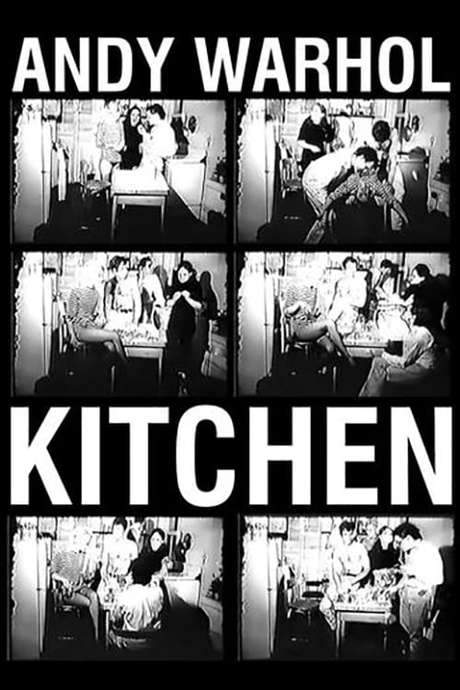
Kitchen
Year: 1966
Runtime: 66 mins
Language: English
Director: Andy Warhol
Andy Warhol asked Ronald Tavel to write a vehicle for Edie Sedgwick in a white kitchen, creating an iconic short. A cast of actors and objects—sink, trash basket—are thrust into absurd comic theater. In the cramped, filled kitchen, boredom, confusion and dread mingle with conflict, turning the space into a laboratory of self‑creation.
Warning: spoilers below!
Haven’t seen Kitchen yet? This summary contains major spoilers. Bookmark the page, watch the movie, and come back for the full breakdown. If you're ready, scroll on and relive the story!
Kitchen (1966) – Full Plot Summary & Ending Explained
Read the complete plot breakdown of Kitchen (1966), including all key story events, major twists, and the ending explained in detail. Discover what really happened—and what it all means.
Devised to highlight Edie Sedgwick as Jo, this directionless black-and-white film opens with the sound of sneezing and a Warhol-style static camera fixed on an empty, white kitchen in a small apartment. The opening voiceover proclaims the reel’s credits in a dry, almost documentary tone: > “Reel one of Andy Warhol’s Kitchen, starring Edie Sedgwick as Jo and Roger Trudeau as Mickey, special assistance Buddy Wirtschafter, scenario by Ronald Tavel, directed by Andy Warhol.” The moment freezes the mood as Sedgwick’s voice lists the everyday objects in the kitchen, including a malted machine—an electric mixer—that becomes a repeated motif in the film, a symbol of domestic routine intersecting with performance. The voice also reveals a quirky secret: scripts are hidden on the set so actors can pretend to read books or glance at the wall calendar whenever lines slip away.
As Jo enters the kitchen, the scene broadens into a loose, almost improvised tableau. Rene Ricard appears as the Busboy and begins washing the dishes in the sink, grounding the action in mundane labor even as the mood remains unsettled. Jo, now on the scene, applies her makeup while a photographer—David McCabe—steps in, snaps a few shots, and then exits, leaving the room to drift again. Roger Trudeau as Mickey follows, and the two performers stumble through lines that seem barely remembered, their delivery as stiff as the furniture surrounding them. Jo then clambers onto the table to exercise, a bold display of legs and form that sits beside the clumsy, half-spoken conversations about sex. The dishwasher remains turned away from the camera, watching the spectators of this odd domestic drama.
A playful, almost punitive moment arrives when Jo pretends to discipline Mickey with a faux spanking, a gesture that sits at the edge of propriety and performance. When Mickey begins a long, earnest monologue, Jo reaches for the electric mixer and turns it on, drowning out all spoken dialogue with the rising grind of the motor. The result is a strange, rhythmic noise that prompts Jo to laugh and dance, surrendering the scene to sound over speech. The mood shifts from staged performance to a more abstract, almost hypnotic atmosphere, where the audience is left to interpret the silence and the tremor of the device’s hum.
The second reel appears with a new altarpiece of voices and credits. Jo studies her script again, and a male voice off-screen announces, “Reel 2 of Andy Warhol’s Kitchen starring Edie Sedgwick.” This meta-statement expands the sense of audience, crew, and onlookers threading through the film’s space. The narration then lists the rest of the cast and notes the technical involvement of Gerard Malanga, whose presence reinforces the collaborative texture of Warhol’s world and the film’s method of blending documentary cues with performative theater. The directions to the actors follow, keeping the sense of a rehearsal that never truly ends.
The malted machine returns, turned on and off in a repetitive, almost ritual fashion that anchors the scene in familiar domestic imagery while pushing it toward absurdity. The dialogue—deliberately aimless and passionless—continues as more actors drift into the kitchen, including [David McCabe], Donald Lyons, and Elecktrah Lobel, each contributing to the chaotic choreography of entrances and exits. Jo spills coffee across the table, a small accident that intensifies the sense that the room is a living stage rather than a fully realized home.
As the film leans further into the feel of a reality-television vignette, Jo sustains a burn on her hand from the stove, and the others react with a staggered mix of concern, indifference, and reflexive filming-like behavior. The illusion of being constantly watched grows stronger, as if the actors are aware of cameras that no longer feel present. In the final beats, Gerard Malanga reappears to take a cold drink from the fridge, a quiet exit that signals the end of the chaotic yet carefully designed performance.
This piece, though short and seemingly improvised, unfolds with a deliberate structure: a static, voyeuristic setup, a self-referential crookery of credits, and a steady erosion of narrative clarity into ritual and noise. The repeated motifs—the malted machine, the hidden scripts, the off-kilter exchanges about intimacy, and the creeping sense that the camera has eclipsed performance—are all elements that invite viewers to read Warhol’s Kitchen as a portrait of collaboration, spectacle, and the blurred lines between art, life, and television. The film remains loyal to its minimalist roots while embracing a stark, almost clinical presentation of its performers, turning an ordinary kitchen into a stage for a quiet, persistent exploration of presence, attention, and the boundaries of cinema itself.
Last Updated: October 09, 2025 at 10:46
Unlock the Full Story of Kitchen
Don't stop at just watching — explore Kitchen in full detail. From the complete plot summary and scene-by-scene timeline to character breakdowns, thematic analysis, and a deep dive into the ending — every page helps you truly understand what Kitchen is all about. Plus, discover what's next after the movie.
Kitchen Timeline
Track the full timeline of Kitchen with every major event arranged chronologically. Perfect for decoding non-linear storytelling, flashbacks, or parallel narratives with a clear scene-by-scene breakdown.



